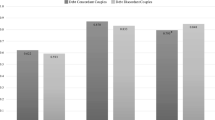Abstract
We use unique data in which both partners report about household finances to demonstrate that there is often disagreement about whether the household has experienced financial difficulty in the past year. Four alternative explanations for this disagreement are tested using the data. The results indicate that disagreement may be related to the severity of the underlying material hardship rather than to gender differences or individual (as opposed to household) views of financial difficulty. We find limited evidence that for some couples information asymmetries contribute to explaining disagreement about financial difficulty. This implies that standard surveys which collect information about the household’s financial position from a representative individual may fail to completely characterize the nature of material hardship.
Similar content being viewed by others
References
Bauman, K. (1999a). “Extended measures of well-being: Meeting basic needs”, Current Population Reports, Household Economic Studies, P70–67. Washington, DC: US Bureau of the Census.
Bauman, K. (1999b). Shifting family definitions: The effect of cohabitation and other nonfamily household relationships on measures of poverty. Demography, 36(3), 315–325.
Behreman, J. (1997). Intrahousehold distribution and the family. In M. R. Rozensweig & O. Stark (Eds.), Handbook of population and family economics. Amsterdam: Elsevier Science BV.
Bergstrom, T. (1997). A survey of theories of the family. In M. R. Rozensweig & O. Stark (Eds.), Handbook of population and family economics. Amsterdam: Elsevier Science BV.
Bray, R. (2001). “Hardship in Australia: An analysis of financial stress indicators in the 1998–99 Australian Bureau of statistics household expenditure survey” Occasional Paper, No. 4, Department of Family and Community Services.
Conger, R., Lorenz, F., Elder, G., Simons, R., & Ge, X. (1993). Husband and wife differences in response to undesirable life events. Journal of Health and Social Behavior, 34(1), 71–88.
Dobbelsteen, S., & Kooreman, P. (1997). Financial management, bargaining and efficiency within the household: An empirical analysis. De Economist, 145(3), 345–366.
HILDA, (2002). HILDA Survey Annual Report 2002. Melbourne Institute of applied economic and social research, University of Melbourne.
Kalugina, E., Radtchenko, N., & Sofer C. (2005). “Using self-reported income in a collective model: within-household income comparisons.” Unpublished working paper.
La Cava, G., & Simon, J., (2003). “A tale of two surveys: household debt and financial constraints in Australia”, Research Discussion Paper, 2003–008, Reserve Bank of Australia, July.
Layte, R., Maitre, B., Nolan, B., & Whelan, C. (2000). “Explaining levels of deprivation in the European Union”, European panel analysis working paper No. 12, Institute for Social and economic research, University of Essex, Colchester, May 2000.
Mayer, S., & Jencks, C. (1989). Poverty and the distribution of material hardship. Journal of Human Resources, XXIV(1), 88–114.
Pahl, J. (1995). His money, her money: Recent research on financial organisation in marriage. Journal of Economic Psychology, 16, 361–376.
Plug, E., & van Praag, B. (1998). Similarity in response behavior between household members: An application for income evaluation. Journal of Economic Psychology, 19, 497–513.
Vuong, Q. (1989). Likelihood ratio tests for model selection and non-nested hypotheses. Econometrica, 57, 307–333.
Watson, N., & Wooden, M. (2002). “The household, income and labour dynamics in Australia (HILDA) Survey: Wave 1 Survey Methodology”, HILDA Project Technical Paper Series, No. 1/02, May, Melbourne Institute of Applied Economic and Social Research, University of Melbourne.
Whelan, C., Layte, R., Maitre, B., & Nolan, B. (2001). “Persistent income poverty and deprivation in the European union: An analysis of the first three waves of the European community household panel”, European Panel Analysis Working Paper No. 17, Institute for Social and Economic Research, University of Essex, Colchester, April 2001.
Zagorsky, J. (2003). Husbands’ and wives’ view of family finances. Journal of Socio-Economics, 32, 127–146.
Acknowledgements
The authors would like to thank participants of the Australasian Econometric Society Meetings 2004 and the European Society for Population Economics Meetings 2005, seminar participants at the University of Groningen, and Peter Kooreman for their comments. We have benefited from the comments of the editor and two anonymous referees. All errors remain our own.
Author information
Authors and Affiliations
Corresponding author
Rights and permissions
About this article
Cite this article
Breunig, R., Cobb-Clark, D.A., Gong, X. et al. Disagreement in Australian partners’ reports of financial difficulty. Rev Econ Household 5, 59–82 (2007). https://doi.org/10.1007/s11150-007-9005-2
Received:
Accepted:
Published:
Issue Date:
DOI: https://doi.org/10.1007/s11150-007-9005-2




